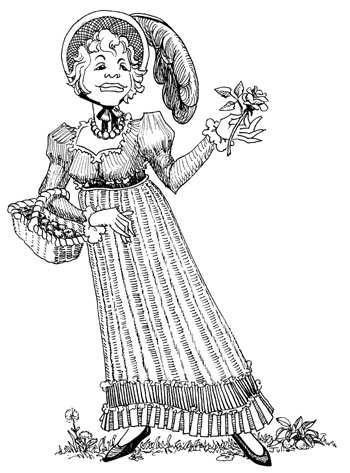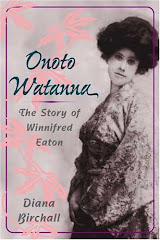

"Mrs. Elton was neither handsome, clever, nor rich" - from In Defense of Mrs. Elton by Diana Birchall, illustrations by Juliet McMaster
Mrs. Birchall (notebook in hand): Hello, Mrs. Elton. Thank you for agreeing to see me on such short notice. I have come to Highbury to solicit your opinion.
Mrs. Elton: My opinion? Well! Only fancy. Few people, I think, can be less forward in giving their opinion than me. You will not find me eager to say what I think; far from it. If there is any thing I cannot endure it is a woman who gives her opinion too decidedly.
Mrs. Birchall: Well, if you are reluctant, I can go away and interview Miss Bates. I'm sure she'll have plenty to say.
Mrs. Elton: Stay. If I really must give my opinion, of course I will do so. I would not disappoint a visitor for the world. That would be extremely rude.
Mrs. Birchall: Very well, then. Here goes. My readers are interested in finding out how things are getting
along in Highbury. You seem to be just the person to tell us.
Mr. and Mrs. Elton, played by Alan Cummings and Juliet Stevenson in the 1996 Emma
Mrs. Elton (flattered): Do I? I do not pretend to be the patroness of the place. It would not be proper for a vicar's wife to take a leading part in society, and I do not at all aspire to such a state.Mrs. Birchall: Certainly not. And we all know, don’t we, that Mrs. Knightley is the great lady of Highbury.
Mrs. Elton (bridling): Mrs. Knightley! Well, that is - Yes, she gives herself such airs, that any stranger to the place might be taken in, and believe she is the fine lady of title and quality she fancies herself to be! But I assure you, that is not the case. The truly genteel people of Highbury, the most select, consider her quite an upstart, I can assure you. We are not taken in by her presuming ways.
Mrs. Birchall: Oh! But I thought that she was from a very ancient family. Doesn't it say so, right there in Emma? Yes, I thought so..here is what Jane Austen says herself:
"He must know that the Woodhouses had been settled for several generations at Hartfield, the younger branch of a very ancient family -- and that the Eltons were nobody."
(Mrs. Elton ruffles like a partridge and starts to puff.)


The first sight of Mrs. Elton at church
Mrs. Elton: Nobody! Well, I like that! Miss Austen has an editorial way that is positively - That woman will say anything! She knew nothing of my husband's antecedents when she wrote that scurrilous book, not to mention my own connections. Emma, indeed! I do assure you that we are related to some very fine folks and move in quite another sphere. Why, my brother, Mr. Suckling, owns a great deal of property, and drives a barouche-landau, which Mrs. Knightley, who seldom stirs beyond her own park-paling, never does.
Mrs. Birchall: (Tactfully) Perhaps we ought to change this subject. I only meant to inquire about the various townspeople. We were speaking of Miss Bates. I always did like her. How is she?
Mrs. Elton: Upon my word! You are commencing at the bottom, are you not? Why, she is scarcely genteel. If she were not a vicar's daughter, she never would have been received in polite company. A sad, poor old maid, and with such manners!
Mrs. Birchall: I believe she is very kind hearted, and very well liked in general.
Mrs. Elton (disdainfully): Oh! Well, if you care for that sort of thing. Any way, since her old mother died, she has done very well for herself. You must know, she cast herself quite upon the charity of the Churchills, and you will hardly credit it, but Jane and Mr. Frank Churchill have actually taken her into their home, at Enscombe, in Yorkshire. When she was practically a beggar, too. Quite shameless.
Mrs. Birchall: Well, but that is very nice of them, and very nice for Miss Bates, too. I am glad to hear it. And Harriet - how is she, and all the good Martins?
Mrs. Elton: (swivels around to stare at her interviewer incredulously) I thought that you were to ask me about the ladies and gentlemen of Highbury.

The Eltons with Harriet
(illustration by Juliet McMaster)
(illustration by Juliet McMaster)
Mrs. Birchall: Why, yes.
Mrs. Elton (pityingly): If you cannot tell gentry from common farmers…
Mrs. Birchall: (gently) I only want to know how they are.
Mrs. Elton: Oh, very well I suppose. Mrs. Martin has got another child, I’ve lately heard. Six or seven of them now. Quite shocking the way they breed, but I will say that at least they are not upon the parish.
Mrs. Birchall: My readers will be glad to hear it. And of course we know that the Knightleys are all doing well, since the sad passing of Mr. Woodhouse, and the Westons are prospering…
Mrs. Elton: Oh, certainly; good creatures they are, though hardly people of elegance or fashion. The Westons are well enough to associate with in a little country place such as Highbury. They would be nobody in Bath.
Mrs. Birchall: Now I come to a more modern question. What do you think of all the sequels to Miss Austen’s stories, that have lately appeared?
Mrs. Elton: Why, to say the truth, I am sadly affronted.
Mrs. Birchall: And why is that? Do you disapprove of them?
Mrs. Elton: To be sure I do. Most of them are finishings of Pride and Prejudice, which I consider quite unfitting. Such a coarse novel, with that young girl running off before her marriage. Dreadful. We do not have such happenings in Highbury. And there are worse things, I know (nodding wisely) in Sense and Sensibility.
Mrs. Birchall: Do you think that is why there are so few sequels to Emma?
Mrs. Elton: Perhaps. You know how the vulgar mind doats upon scandal.

Mrs. Elton and her housekeeper
Mrs. Birchall: Then you would like to see more sequels to Emma?
Mrs. Elton: I? I should say not. Why should that arrogant upstart of a woman receive even more fame and attention than has already fallen to her lot, quite undeservedly? She always gets more than her due, and has from a girl.
Mrs. Birchall: Do you mean Jane Austen?
Mrs. Elton: No! I mean Emma! Why should I want to see her get more glory than ever, films and all that sort of thing, when sterling characters are passed by?

Very few pearls like Mrs. Elton's.
Mrs. Birchall: (slyly) Such as yourself?
Mrs. Elton: If you must speak of me, why, yes, as a matter of fact.
Mrs. Birchall: But don’t you know that I have written a sequel, a novel, that is all about you?
Mrs. Elton: No, I didn’t know. (Tosses head disdainfully) It cannot be much of a best-seller. Mr. E. and I read all the reviews in the London Times, and we have never heard of it.
Mrs. Birchall: Yes, well you see, I am an American.
Mrs. Elton: Exactly so! Then how could you presume to take it upon yourself to write about an English person – especially one of good breeding?
Mrs. Birchall: Perhaps I have as much fortitude as you have yourself. Be that as it may, my first “Mrs. Elton” story, In Defense of Mrs. Elton, was published by the Jane Austen Society of North America, as well as in Australia, and sold in your own England as well. It is now collected into a volume with other stories, called Mrs. Elton in America. Sourcebooks publishes it. Would you like to read a copy? I believe you would like it. Here.
Mrs. Elton: A book? All about me? Is that so?
(she grabs the volume and starts devouring it greedily)
Mrs. Birchall: Well, it looks like I have made one sale, at least.
I had to bring Mrs. Elton in America to its eponymous heroine via imagination only; but you can order the book on Amazon. Which is almost as miraculous!

From an advice column Mrs. Elton wrote for the Jane Austen Today blog a couple of years (or centuries) ago! http://janitesonthejames.blogspot.com/2008/07/mrs-elton-sez-governess-presents.html
If you wish to ask Mrs. Elton a question yourself, you may send it to birchalls@aol.com, and I will certainly see that she gets it.



















































































